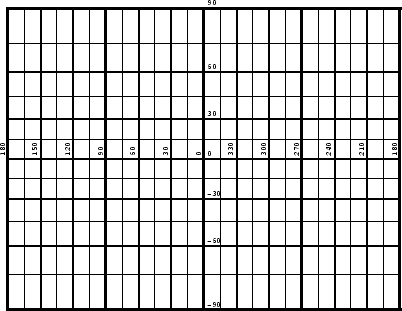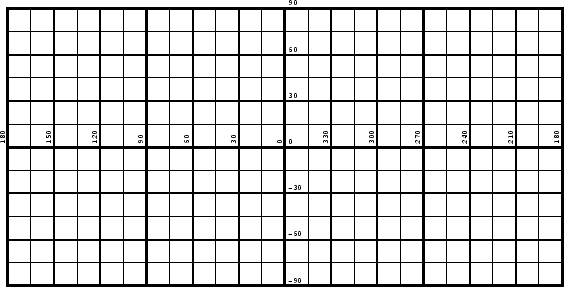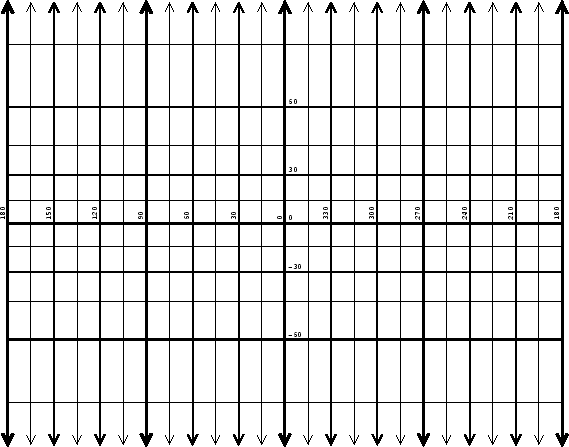
 News News |
 FAQ FAQ
|
 Search Search
|
 Home Home
|
| Getting Started | Documentation | Glish | Learn More | Programming | Contact Us |

| Version 1.9 Build 1556 |
|
Cylindrical projections are a class of projections in which the surface of projection is a cylinder whose axis intercepts the centre of the generating sphere. The native coordinate system is such that the polar axis is coincident with the axis of the cylinder. Meridians and parallels are mapped onto a retangular grid. The projection is therefore described directly by formulae which return x, and y. All cylindricals have
|
x |
(34) |
and this may be inverted as
|
|
(35) |
The requirement for conformality of cylindrical projections is

|
(36) |
and since
|
|
(37) |
the general solution is
y 
|
(38) |
and this is the basis of Mercator's projection.
Let an oblique coordinate system be denoted by
(![]() ,
,![]() ), and let
the coordinates of the pole [??? (0,0)] of the native coordinate system in the
oblique system be
(
), and let
the coordinates of the pole [??? (0,0)] of the native coordinate system in the
oblique system be
(![]() ,
,![]() ). The meridian of the oblique system
defined by
). The meridian of the oblique system
defined by
![]() =
= ![]() will be projected as a straight line segment;
suppose it overlies the native meridian of
will be projected as a straight line segment;
suppose it overlies the native meridian of
![]() =
= ![]() in the same sense
of increasing or decreasing latitude (to distinguish it from the native
meridian on the opposite side of the pole), then the Euler angles for the
transformation from
(
in the same sense
of increasing or decreasing latitude (to distinguish it from the native
meridian on the opposite side of the pole), then the Euler angles for the
transformation from
(![]() ,
,![]() ) to
(
) to
(![]() ,
,![]() ) are
) are
|
( |
(39) |
In the general case the radius of the cylinder is
![]() r0, where r0
is the radius of the generating sphere, and the point of projection is distant
r0, where r0
is the radius of the generating sphere, and the point of projection is distant
![]() r0 from the centre of the sphere. If
r0 from the centre of the sphere. If
![]()
![]() 0 the point of
projection moves around a circle of radius
0 the point of
projection moves around a circle of radius ![]() r0 in the equatorial plane
of the generating sphere depending on the meridian being projected. The case
r0 in the equatorial plane
of the generating sphere depending on the meridian being projected. The case
![]() < 0 is allowable, however
< 0 is allowable, however
![]()
![]() -
- ![]() .
.
...diagram...
It is straightforward to show that
| x | = | - r0 |
(40) |
| y | = | r0sin
|
(41) |
For ![]() = 0, where the point of projection is at the centre of the
generating sphere, the effect of
= 0, where the point of projection is at the centre of the
generating sphere, the effect of ![]() is to scale the projection
uniformly in x and y.
is to scale the projection
uniformly in x and y.
The equations for x and y are invertible as follows:
| = | - |
(42) | |
| = | arg(1, |
(43) |
where
|
|
(44) |
Limits for the perspective cylindrical projections are determined by the
value of ![]() rather than
rather than ![]() which mainly affects the relative scaling
of the x and y axes.
which mainly affects the relative scaling
of the x and y axes.
The requirement for conformality of perspective cylindrical projections is
|
[ |
(45) |
For ![]() = 0 the projection is conformal at the equator for all values of
= 0 the projection is conformal at the equator for all values of
![]() . For
. For ![]() = 1 the projection is conformal at latitudes
= 1 the projection is conformal at latitudes
![]() =
= ![]() cos-1
cos-1![]() , and this is the basis of Gall's
projection.
, and this is the basis of Gall's
projection.
In this simplest case of a perspective cylindrical projection the point of projection is at the centre of the generating sphere and the cylinder intersects the equator.
| = | 0, | (46) | |
| = | 1, | (47) | |
| x | = | - r0 |
(48) |
| y | = | r0tan |
(49) |
| = | - |
(50) | |
| = | tan-1 |
(51) |

Limits: diverges at latitudes
![]() =
= ![]() 90o.
90o.
Conformal at latitude
![]() = 0o.
= 0o.
This projection, which is conformal at latitudes
![]() =
= ![]() 45o,
minimizes distortions in the equatorial regions.
45o,
minimizes distortions in the equatorial regions.
| = | 1 | (52) | |
| = | (53) | ||
| x | = | - r0 |
(54) |
| y | = | r0 |
(55) |
| = | -  , , |
(56) | |
| = | 2tan-1
|
(57) |

Limits: none.
Conformal at latitudes
![]() =
= ![]() 45o.
45o.
This perspective projection is a specific instance of a subclass of non-perspective equal area cylindrical projections. See also generalized equal area cylindrical projections.
| = | (58) | ||
| = | 1, | (59) | |
| x | = | - r0 |
(60) |
| y | = | r0sin |
(61) |
| = | - |
(62) | |
| = | sin-1 |
(63) |

Limits: none.
Conformal at latitude
![]() = 0o.
= 0o.
Each of the non-perspective projections discussed here has
|
x = - r0 |
(64) |
and inverse
|
|
(65) |
Also known as Cartesian projection, this projection is easy to construct and take measurements from.
| y | = | r0 |
(66) |
| = | - |
(67) |

Limits: none
Conformal at latitude
![]() = 0o.
= 0o.
This is a conformal projection with the useful property that lines of constant bearing (rhumb lines) are projected as straight lines. Consequently, it has been widely used for navigational purposes.
| y | = | r0lntan
|
(68) |
| = | 2tan-1 |
(69) |

Limits: diverges at latitudes
![]() =
= ![]() 90o.
90o.
Conformal at all points.
Parallels are spaced so as to make the projection equal area, and scaled so as
to make it conformal at latitudes
![]() =
= ![]()
![]() . The area of a
region on the projection is
1/cos2
. The area of a
region on the projection is
1/cos2![]() times larger than that of
the corresponding region on the generating sphere. The case with
times larger than that of
the corresponding region on the generating sphere. The case with
![]() = 1 is Lambert's projection.
= 1 is Lambert's projection.
| y | = | r0 |
(70) |
| = | sin-1
|
(71) |
Limits: none.
Conformal at latitudes
![]() =
= ![]()
![]() .
.